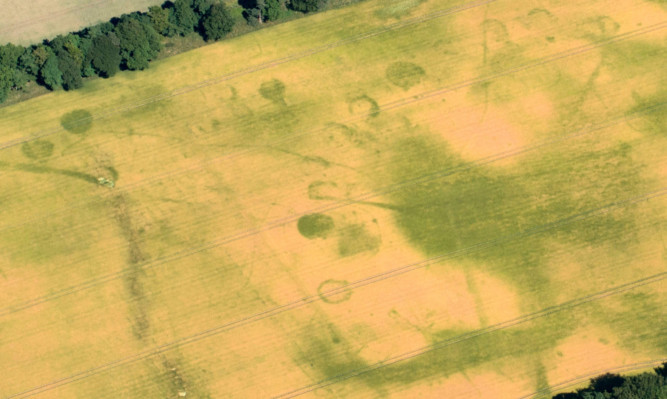With one eye on recording Scotland’s ancient history and another on the ground, Dave Cowley is the Indiana Jones of the skies.
He is aerial survey projects manager with Royal Commission of Ancient and Historical Monuments of Scotland (RCAHMS) and he and his colleagues make 40 to 50 trips a year in a four-seater Cessna to record rare glimpses of the past.
And this hot, dry summer has provided the best conditions in years to see crop marks, which reveal evidence of ancient settlements long lost to modern agriculture methods.
While farmers rue the arid weather, Mr Cowley said now is the time to take to the air and survey “the glorious detail” of Roman forts and Iron Age camps “lost” since the 1970s.
Different crop growth enabled him to take the fantastic images of Roman and possible prehistoric camps shown left.
The outline of the Roman fort is clearly seen at Stracathro in Angus and Mr Cowley had the good luck to fly over definite outlines of prehistoric roundhouses in Inverkeilor.
He said: “Between 75 and 80 per cent of what we know about the past comes through the use of aerial photography and the past few weeks have provided a fantastic opportunity to add to that knowledge.
“Last year was a bit of a write-off as it was so wet. We got some half-decent finds in 2006 but for anything that compares with the glorious detail we’ve been finding over the past few weeks, you’d need to go back to 1976 or 77.”
Historians have the ability to contrast new and old photos to see changes, before they are added to the RCAHMS photo archive of more than 1.6 million images.
Mr Cowley said summer is good for archaeology under the land and water and autumn is the best time to capture built heritage.
The use of aerial photography for archaeology became apparent after the First World War but the technology flourished when planes were adapted to its needs.
Mr Cowley said: “Back then, aerial photography revolutionised the field of archaeology and created a sea-change in the amount of information we had on ancient sites around the country.”
The Roman Gask project has extensively researched the area at Stracathro, near Brechin, at which evidence of the world’s most northern Roman fort was found in 1957.
Its co-director, Dr Birgitta Hoffman of Liverpool University, said the dig had found “some of the best evidence to date” to back up a theory which suggests Roman citizens may have mixed with the “vulgar” natives.
Archaeologists found the spout of a wine jug among evidence pointing to the existence of a wine bar or taverna, what Dr Hoffman thought “could be identifiable as the Roman equivalent of a pub.”
Visit youtubeto find out more.
